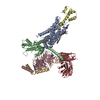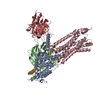+ Open data
Open data
- Basic information
Basic information
| Entry | Database: PDB / ID: 8hk3 | ||||||
|---|---|---|---|---|---|---|---|
| Title | C3aR-Gi-apo protein complex | ||||||
 Components Components |
| ||||||
 Keywords Keywords | MEMBRANE PROTEIN / GPCR / C3aR / complement | ||||||
| Function / homology |  Function and homology information Function and homology informationcomplement component C3a receptor activity / complement component C5a receptor activity / complement receptor mediated signaling pathway / G-protein activation / Activation of the phototransduction cascade / Glucagon-type ligand receptors / Thromboxane signalling through TP receptor / Sensory perception of sweet, bitter, and umami (glutamate) taste / G beta:gamma signalling through PI3Kgamma / G beta:gamma signalling through CDC42 ...complement component C3a receptor activity / complement component C5a receptor activity / complement receptor mediated signaling pathway / G-protein activation / Activation of the phototransduction cascade / Glucagon-type ligand receptors / Thromboxane signalling through TP receptor / Sensory perception of sweet, bitter, and umami (glutamate) taste / G beta:gamma signalling through PI3Kgamma / G beta:gamma signalling through CDC42 / Cooperation of PDCL (PhLP1) and TRiC/CCT in G-protein beta folding / Activation of G protein gated Potassium channels / Inhibition of voltage gated Ca2+ channels via Gbeta/gamma subunits / Ca2+ pathway / G alpha (z) signalling events / High laminar flow shear stress activates signaling by PIEZO1 and PECAM1:CDH5:KDR in endothelial cells / Glucagon-like Peptide-1 (GLP1) regulates insulin secretion / Vasopressin regulates renal water homeostasis via Aquaporins / Adrenaline,noradrenaline inhibits insulin secretion / ADP signalling through P2Y purinoceptor 12 / G alpha (q) signalling events / positive regulation of neutrophil chemotaxis / blood circulation / G alpha (i) signalling events / Thrombin signalling through proteinase activated receptors (PARs) / Activation of G protein gated Potassium channels / G-protein activation / G beta:gamma signalling through PI3Kgamma / Prostacyclin signalling through prostacyclin receptor / G beta:gamma signalling through PLC beta / ADP signalling through P2Y purinoceptor 1 / Thromboxane signalling through TP receptor / Presynaptic function of Kainate receptors / G beta:gamma signalling through CDC42 / Inhibition of voltage gated Ca2+ channels via Gbeta/gamma subunits / G alpha (12/13) signalling events / Glucagon-type ligand receptors / G beta:gamma signalling through BTK / ADP signalling through P2Y purinoceptor 12 / Adrenaline,noradrenaline inhibits insulin secretion / Cooperation of PDCL (PhLP1) and TRiC/CCT in G-protein beta folding / Ca2+ pathway / Thrombin signalling through proteinase activated receptors (PARs) / G alpha (z) signalling events / Extra-nuclear estrogen signaling / azurophil granule membrane / G alpha (s) signalling events / photoreceptor outer segment membrane / G alpha (q) signalling events / spectrin binding / G alpha (i) signalling events / Glucagon-like Peptide-1 (GLP1) regulates insulin secretion / High laminar flow shear stress activates signaling by PIEZO1 and PECAM1:CDH5:KDR in endothelial cells / Vasopressin regulates renal water homeostasis via Aquaporins / positive regulation of macrophage chemotaxis / alkylglycerophosphoethanolamine phosphodiesterase activity / positive regulation of vascular endothelial growth factor production / photoreceptor outer segment / specific granule membrane / Purinergic signaling in leishmaniasis infection / adenylate cyclase inhibitor activity / positive regulation of protein localization to cell cortex / T cell migration / Adenylate cyclase inhibitory pathway / D2 dopamine receptor binding / response to prostaglandin E / cardiac muscle cell apoptotic process / photoreceptor inner segment / adenylate cyclase regulator activity / G protein-coupled serotonin receptor binding / adenylate cyclase-inhibiting serotonin receptor signaling pathway / cellular response to forskolin / Peptide ligand-binding receptors / Regulation of Complement cascade / regulation of mitotic spindle organization / Regulation of insulin secretion / calcium-mediated signaling / positive regulation of cholesterol biosynthetic process / negative regulation of insulin secretion / G protein-coupled receptor binding / response to peptide hormone / G protein-coupled receptor activity / adenylate cyclase-inhibiting G protein-coupled receptor signaling pathway / adenylate cyclase-modulating G protein-coupled receptor signaling pathway / centriolar satellite / G-protein beta/gamma-subunit complex binding / chemotaxis / positive regulation of angiogenesis / ADP signalling through P2Y purinoceptor 12 / Adrenaline,noradrenaline inhibits insulin secretion / GDP binding / G alpha (z) signalling events / cellular response to catecholamine stimulus / ADORA2B mediated anti-inflammatory cytokines production / adenylate cyclase-activating dopamine receptor signaling pathway / GPER1 signaling / G-protein beta-subunit binding / cellular response to prostaglandin E stimulus / heterotrimeric G-protein complex / sensory perception of taste Similarity search - Function | ||||||
| Biological species |  Homo sapiens (human) Homo sapiens (human)  | ||||||
| Method | ELECTRON MICROSCOPY / single particle reconstruction / cryo EM / Resolution: 3.2 Å | ||||||
 Authors Authors | Wang, Y. / Liu, W. / Xu, Y. / Zhuang, Y. / Xu, H.E. | ||||||
| Funding support |  China, 1items China, 1items
| ||||||
 Citation Citation |  Journal: Nat Chem Biol / Year: 2023 Journal: Nat Chem Biol / Year: 2023Title: Revealing the signaling of complement receptors C3aR and C5aR1 by anaphylatoxins. Authors: Yue Wang / Weiyi Liu / Youwei Xu / Xinheng He / Qingning Yuan / Ping Luo / Wenjia Fan / Jingpeng Zhu / Xinyue Zhang / Xi Cheng / Yi Jiang / H Eric Xu / Youwen Zhuang /  Abstract: The complement receptors C3aR and C5aR1, whose signaling is selectively activated by anaphylatoxins C3a and C5a, are important regulators of both innate and adaptive immune responses. Dysregulations ...The complement receptors C3aR and C5aR1, whose signaling is selectively activated by anaphylatoxins C3a and C5a, are important regulators of both innate and adaptive immune responses. Dysregulations of C3aR and C5aR1 signaling lead to multiple inflammatory disorders, including sepsis, asthma and acute respiratory distress syndrome. The mechanism underlying endogenous anaphylatoxin recognition and activation of C3aR and C5aR1 remains elusive. Here we reported the structures of C3a-bound C3aR and C5a-bound C5aR1 as well as an apo-C3aR structure. These structures, combined with mutagenesis analysis, reveal a conserved recognition pattern of anaphylatoxins to the complement receptors that is different from chemokine receptors, unique pocket topologies of C3aR and C5aR1 that mediate ligand selectivity, and a common mechanism of receptor activation. These results provide crucial insights into the molecular understanding of C3aR and C5aR1 signaling and structural templates for rational drug design for treating inflammation disorders. | ||||||
| History |
|
- Structure visualization
Structure visualization
| Structure viewer | Molecule:  Molmil Molmil Jmol/JSmol Jmol/JSmol |
|---|
- Downloads & links
Downloads & links
- Download
Download
| PDBx/mmCIF format |  8hk3.cif.gz 8hk3.cif.gz | 214 KB | Display |  PDBx/mmCIF format PDBx/mmCIF format |
|---|---|---|---|---|
| PDB format |  pdb8hk3.ent.gz pdb8hk3.ent.gz | 162.9 KB | Display |  PDB format PDB format |
| PDBx/mmJSON format |  8hk3.json.gz 8hk3.json.gz | Tree view |  PDBx/mmJSON format PDBx/mmJSON format | |
| Others |  Other downloads Other downloads |
-Validation report
| Summary document |  8hk3_validation.pdf.gz 8hk3_validation.pdf.gz | 1.1 MB | Display |  wwPDB validaton report wwPDB validaton report |
|---|---|---|---|---|
| Full document |  8hk3_full_validation.pdf.gz 8hk3_full_validation.pdf.gz | 1.1 MB | Display | |
| Data in XML |  8hk3_validation.xml.gz 8hk3_validation.xml.gz | 38 KB | Display | |
| Data in CIF |  8hk3_validation.cif.gz 8hk3_validation.cif.gz | 56.5 KB | Display | |
| Arichive directory |  https://data.pdbj.org/pub/pdb/validation_reports/hk/8hk3 https://data.pdbj.org/pub/pdb/validation_reports/hk/8hk3 ftp://data.pdbj.org/pub/pdb/validation_reports/hk/8hk3 ftp://data.pdbj.org/pub/pdb/validation_reports/hk/8hk3 | HTTPS FTP |
-Related structure data
| Related structure data |  34843MC  8hk2C  8hk5C M: map data used to model this data C: citing same article ( |
|---|---|
| Similar structure data | Similarity search - Function & homology  F&H Search F&H Search |
- Links
Links
- Assembly
Assembly
| Deposited unit | 
|
|---|---|
| 1 |
|
- Components
Components
| #1: Protein | Mass: 40313.863 Da / Num. of mol.: 1 Source method: isolated from a genetically manipulated source Source: (gene. exp.)  Homo sapiens (human) / Gene: GNAI1 / Production host: Homo sapiens (human) / Gene: GNAI1 / Production host:  |
|---|---|
| #2: Protein | Mass: 37915.496 Da / Num. of mol.: 1 Source method: isolated from a genetically manipulated source Source: (gene. exp.)   |
| #3: Protein | Mass: 53247.195 Da / Num. of mol.: 1 Source method: isolated from a genetically manipulated source Source: (gene. exp.)  Homo sapiens (human) / Gene: C3AR1, AZ3B, C3R1, HNFAG09 / Production host: Homo sapiens (human) / Gene: C3AR1, AZ3B, C3R1, HNFAG09 / Production host:  |
| #4: Protein | Mass: 7432.554 Da / Num. of mol.: 1 Source method: isolated from a genetically manipulated source Source: (gene. exp.)   |
| #5: Antibody | Mass: 26277.299 Da / Num. of mol.: 1 Source method: isolated from a genetically manipulated source Source: (gene. exp.)   |
| Has ligand of interest | N |
| Has protein modification | Y |
-Experimental details
-Experiment
| Experiment | Method: ELECTRON MICROSCOPY |
|---|---|
| EM experiment | Aggregation state: PARTICLE / 3D reconstruction method: single particle reconstruction |
- Sample preparation
Sample preparation
| Component | Name: C3aR-Gi-apo protein complex / Type: COMPLEX / Entity ID: all / Source: MULTIPLE SOURCES |
|---|---|
| Molecular weight | Value: 0.16 MDa / Experimental value: NO |
| Source (natural) | Organism:  Homo sapiens (human) Homo sapiens (human) |
| Source (recombinant) | Organism:  |
| Buffer solution | pH: 7.2 |
| Specimen | Embedding applied: NO / Shadowing applied: NO / Staining applied: NO / Vitrification applied: YES |
| Vitrification | Cryogen name: ETHANE |
- Electron microscopy imaging
Electron microscopy imaging
| Experimental equipment |  Model: Titan Krios / Image courtesy: FEI Company |
|---|---|
| Microscopy | Model: FEI TITAN KRIOS |
| Electron gun | Electron source:  FIELD EMISSION GUN / Accelerating voltage: 300 kV / Illumination mode: FLOOD BEAM FIELD EMISSION GUN / Accelerating voltage: 300 kV / Illumination mode: FLOOD BEAM |
| Electron lens | Mode: BRIGHT FIELD / Nominal defocus max: 5000 nm / Nominal defocus min: 1200 nm |
| Image recording | Electron dose: 50 e/Å2 / Film or detector model: GATAN K3 (6k x 4k) |
- Processing
Processing
| CTF correction | Type: NONE |
|---|---|
| Particle selection | Num. of particles selected: 4404753 |
| 3D reconstruction | Resolution: 3.2 Å / Resolution method: FSC 0.143 CUT-OFF / Num. of particles: 275847 / Symmetry type: POINT |
 Movie
Movie Controller
Controller





 PDBj
PDBj

































